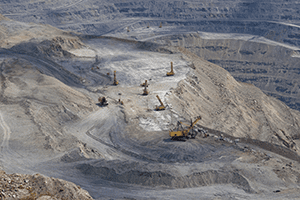What began as an international research and technology transfer project has changed the way the mining industry approaches open pit design. Tony Heselev reports.
When CSIRO senior manager Dr John Read brought together a group of industry contacts at a conference in Santiago in 2004 to sound out the idea of pooling knowledge of open pit mine stability, he was pleasantly surprised with the reaction.
 The contacts, representing major mining houses, backed his idea, providing the genesis for what is now known as the large open pit mine slope stability project.
The contacts, representing major mining houses, backed his idea, providing the genesis for what is now known as the large open pit mine slope stability project.
Dr Read could not have dreamed that it would have been so successful however, setting industry standards for reliable large open pit mine design around the world.
‘There was immediate support from the group for a shared and better understanding of the geological interactions associated with rock mass failure and recognition of the need for new guidelines for reliable slope design,’ Dr Read says.
The project has addressed an industry-wide need to improve understanding of the relationship between the strength and deformability of rock and the likely mechanisms of failure in large open pit mines.
It includes innovative geomechanics research, such as three-dimensional structural modelling, and is helping mine managers minimise the risk of loss of life, equipment damage and sustained production losses in the event of slope failure.
The project is coordinated by CSIRO and sponsored by 12 mining companies representing most of the world’s base metals and diamond producers.
By the end of this year, CSIRO and its partners will have produced four books to guide professionals such as geotechnical, mining and civil engineers and hydrogeologists in the investigation, design and construction of stable rock slopes.
Chapters are written by the people regarded as having the most expertise in each area – often from the sponsor companies.
The first book, Guidelines for Open Pit Slope Design (2009), links project research with best practice in open pit data collection and management; slope design, management and monitoring; and mining and risk management.
‘The book outlines how you collect reliable data, prepare a geotechnical model, use data for stability analysis, apply that in mine development and monitor the performance of the mine slopes,’ Dr Read says.
‘Failures will always happen, but what we’re trying to do is help manage the risk and diminish the likelihood of having a major failure.
‘Companies can do this by having better design and monitoring practices to keep an eye on what’s going on, especially with slope management and the development of pore water pressure within the rock mass.’
The sponsor companies each provided $100,000 a year for the research, publishing and project coordination.
Dr Marc Ruest, De Beers Global Mining’s group lead of geotechnical and hydrogeology, says the project has been a long-term commitment that has been extraordinarily collaborative.
‘De Beers has benefited significantly from the large open pit project in so many ways. CSIRO has effectively brought together engineers from mining houses around the world to develop a common ground in the critical geotechnical design and implementation issues at our mine,’ he says.
The guidelines developed as part of the project continue to provide our practitioners with a high-quality baseline for the geotechnical programs at our operations.’
Dr Read says the guidelines have helped mine managers become more aware of the need for reliable data and how to assess that data.
It has also improved their understanding and assessment of rock mass strength and how to use that information to better analyse rock stability. This has helped them maximise safety, ore recovery and financial returns over the life of the mine.
‘Risk management is a serious part of the business these days,’ Dr Read says.
‘Companies make huge investments in these mines and the mines are also huge.
Some of the pits are up to 1000 metres deep, for example Chuquicamat in Chile, and some of the walls will be up to 1400 metres high, such as at Pelambres, also in Chile.’
The book is widely used in Australia, South Africa, North and South America.
‘You can find it on the desks of the geotechnical people at pretty much every minesite you care to go and visit,’ Dr Read says.
A second book, on open pit design and water, was published early this year, expanding on a chapter in the original guidelines.
Dr Read says this book provides mine managers with improved information on assessment and monitoring of pore water pressure in closely jointed rock, and how to incorporate this information into stability analyses.
A third book, Guidelines for Open Pit Design in Weak Rocks, and a fourth, Geotechnical Guidelines for Mine Waste Dump and Stockpile Design, will be released later this year.
Dr Read is delighted that at a meeting in Brisbane last September, the sponsor companies decided unanimously to continue the project in some form, even though it is due to be completed in June when his own involvement in the project will end.
“The project has addressed an industry-wide need to improve understanding of the relationship between the strength and deformability of rock and the likely mechanisms of failure in large open pit mines.”
The first two books area available in hard copy and e-format from CSIRO Publishing:
Dr John Read
john.read@csiro.au
+61 7 3327 4460

CSIRO, Research Scientist
PROFILE
CSIRO
Australia is founding its future on science and innovation. Its national science agency, CSIRO, is a powerhouse of ideas, technologies and skills for building prosperity, growth, health and sustainability.
CSIRO’s Minerals Down Under Flagship is one of the largest minerals research groups in the world and has a proven track record of working with industry to deliver innovative solutions. Through targeted research we address the industry’s challenges, driving sustainability, productivity and innovation for our collaborative partners and clients.
This story first appeared in resourceful: www.csiro.au/resourceful














Add Comment